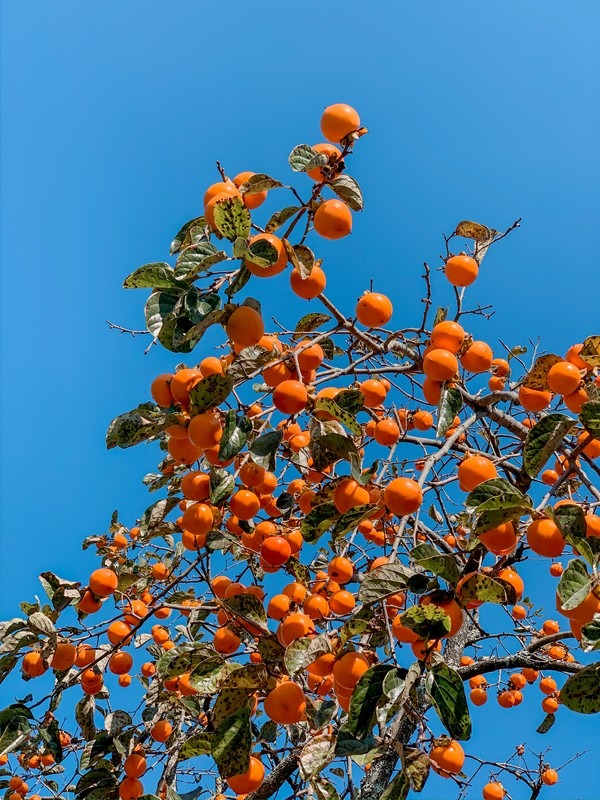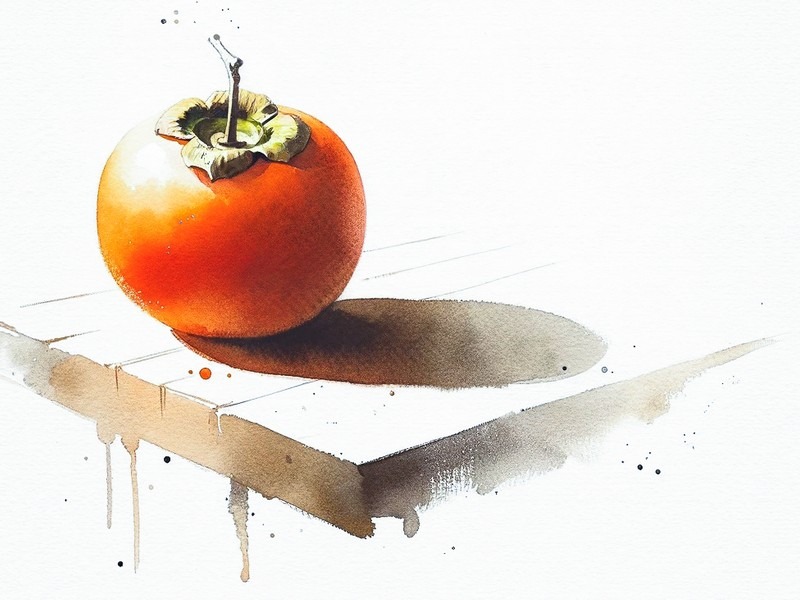Korean Persimmons: The Culture, The Folktales, The Food
Last Updated on February 12, 2024
When autumn comes to Korea there’s no other fruit that represents the season better than persimmon, or gam (감). If you take a trip into the rural countryside of Korea, you will spot beautifully vibrant persimmon hanging everywhere. If you stay in Seoul, you’ll find persimmon desserts and snacks abound.
I hadn’t had persimmon before coming to Korea and when I first got some, I had no idea how to eat it. Is it supposed to be so smushy? Is it supposed to be dried? Candied? I was lucky enough to live near some Korean grandmothers who taught me how to best enjoy Korean persimmons and so I wanted to share it with you. From persimmons in Korean folklore to persimmon festivals in Korea, there are some great ways to celebrate the beauty and taste of the persimmon.

There’s more to know about Korean persimmon, or gam, than you might realize. Let’s get schooled:
- Persimmon Culture Tidbits
- Kinds of Korean Persimmon
- What is Got-gam (곶감)?
- Persimmon Words You Should Know To Shop
- Persimmon Festivals in Korea
(This post contains affiliate links, which means I receive a certain percentage of a sale if you purchase after clicking at no cost to you. Thank you for your support.)


Persimmon Culture Tidbits
Persimmons hold a prominent place in traditional Korean culture. Gifted for the Lunar New Year, they represent good fortune and wealth in the coming year. Gifted at a traditional Korean wedding, they symbolize a wish for a prosperous and harmonious marriage.
As you can see, the persimmon is considered good for fertility and prosperity and the vibrant orange color symbolizes the harvest and abundance for life and longevity. If someone asks if you want persimmons in Korea, all of this to say that you definitely do.
Did you know: When persimmon are harvested from the trees in Korea, a few persimmon are left behind for the magpies. These are called ggachi bap (까치 밥), or magpie food.


The Tiger and the Dried Persimmon Folktale (호랑이와 곶감)
Deep in the mountains, there was a small, quiet village, and on the mountain behind this village lived an enormous tiger, a terrible beast whose roar would make every creature tremble for miles around. One snowy winter evening, the tiger was hungry and he crept down into the village to get something to eat.
By and by, the tiger came to a house and paused outside the window where a baby was crying inside. “Aaang! Aaang! Aaang!” The child sounded exhausted, as if he had been crying for a long time, and yet he went on and on without pause.
“What an annoying brat,” thought the tiger. “By eating him, I’ll put an end to this racket.” He had a quick peek into the room, and he was just about to leap inside when he heard the baby’s mother.
“Look! A fox!” she said. “Stop crying or he’ll hear you and come eat you up!” The baby was hardly distracted—he cried just as loudly. The mother tried to comfort the child, then to cajole him, but he would not stop. So she tried again. “Look! It’s a bear! He’s opening his huge jaws to eat you up!” But the baby wasn’t frightened at all. He kept right on crying without even the smallest interruption.

Crouching outside the window, the tiger pondered this. “What sort of baby is not afraid of foxes or bears?” he thought. “Surely, this is a brave child.” He was full of admiration, but then the rumble in his belly reminded him why he had come down into the village, and he prepared to pounce into the room.
“Look!” cried the mother, “The big tiger from the mountain is here, right outside the window!” At that, the tiger paused. “Let’s see how terrified he is before I eat him,” he thought, and he peeked into the room to gloat. But the baby was still crying without the slightest sign of fear.
The tiger had never, in his long years, come across a human or an animal that did not fear him. Even the trees and stones trembled at his approach. But this boy—what manner of child was he that he did not fear a tiger? The tiger was troubled by this question, but in the end he was a tiger, and he decided to resolve the issue by eating the child.

But just as he was about to pounce, the mother cried, “Look! A persimmon!” and the baby stopped in mid-cry. Just like that! Not a peep. In the sudden silence, a terrible idea occurred to the tiger. “A Persimmon!” he thought. “More fearsome than a fox or a bear! Even more terrible than me! What a horrible monster it must be!” He quickly glanced left and right, his heart pounding with fear. “I’m done for if the Persimmon sees me,” he thought, and in a single leap he left the village and ran away back up into the mountain.


Kinds of Korean Persimmon
There are two main kinds of persimmon in Korea and if you’re going shopping in a traditional market, you’ll want to know what they are as they are used for different things in Korean cuisine.
Fuyu Persimmon (단감)
The naturally sweet persimmon version, the dan-gam has lighter orange colored flesh, is rounder, and has a flat bottom. Usually the first to ripen so you’ll see it the earliest in markets, it has a less intense sweet flavor.
- How to eat it: This persimmon can be eaten with or without the skin just like an apple though most Koreans I know peel them before eating. They should be crunchy or just slightly soft, but don’t try to dry these persimmons. It won’t work. To eat, first remove the leaves and remove the inner core as they’re said to cause constipation.
- How to keep it: If you like them crunchy, store them in a container in the fridge. If you like them softer, keep them out on the counter before eating.

Hachiya Persimmon (대봉감)
Offered to the kings of the Joseon Dynasty as a seasonal tribute, this persimmon is tart if you enjoy it too early. With a deep red rind and shaped like an acorn, it has a soft texture and the sweet persimmon taste emerges as it ripens. It can become VERY sweet. It’s quite fibrous, so this is the persimmon that you’ll usually see hanging to create dried persimmons (곶감 “got-gam”).
- How to eat it: This isn’t the easiest fruit to eat. Like I said above, it can be a bit mushy and requires a spoon the way the Korean grandmas taught me to eat it. You don’t want to eat them before they’re mushy actually. Once they’re ready, you can easily scoop out the pulp and enjoy.
- How to keep it: If you are gifted these like I was and are wondering how to store them, you can put them into a thick cardboard box with the leaf/stem side down. If you have enough to layer, you’ll want to put a piece of cardboard between each layer so they’re not on top of each other. If you get these and they’re not yet soft enough to eat, you can add apples to the box which will release ethylene gas and help to soften them faster.


What is Got-gam (곶감)?
The beautiful drying persimmon that you can see around rural areas in the autumn in Korea are got-gam. They are hung in the autumn for about 45 days and become dense and sugary and have a very jam-like fruitiness. They go through continuous freezing at night and thawing in the autumn sun during the day allowing them to perfectly dry. (This is quite similar to another winter delicacy in Korea called gwamegi.) These persimmons require constant care and is very labor intensive. When said and done, you’ll find them in the markets looking dark, dried, and with a powdery dust on them. When I first saw them with a sort of whitish powder, I thought they had gone off but actually that powder is the sugars from within the fruit.
Since these are much sweeter than the persimmon I’ve already mentioned above, these are usually balanced with unsweetened tea or walnuts might be added.
Gam-mallaengi (감말랭이): There’s another kind of dried persimmon called gam-mallaengi. For these ones, before drying, they are peeled and cut and the pieces shrivel. It feels a bit more like the dried mango you might buy in the market. A bit soft and springy and chewy.

Persimmon Words You Should Know To Shop
Hongsi (홍시), a term that translates to “red persimmon” in Korean, represents the quintessence of ripe, soft persimmons that have reached their peak of sweetness and tenderness. Characterized by a vivid red-orange hue, these persimmons have undergone a natural maturation process that diminishes their tannin content, thereby eliminating any initial bitterness and paving the way for a rich, sweet flavor.
Yeonsi (연시) is a term that also means the persimmon is soft, but instead of ripening naturally, it was artificially ripened. Since they matured in a more controlled environment, they tend to be evenly orange and soft.
On the other hand, bansi (반시), another variety encountered in Korea, offers a unique experience with its flat, round shape and the notable absence of seeds. This particular trait is attributed to its origin in Cheongdo County, North Gyeongsang Province, where a specific agricultural phenomenon occurs: only female persimmon trees are grown, resulting in unpollinated flowers and consequently, seedless fruits.

Persimmon Festivals in Korea
If you want to celebrate the abundance of persimmons in Korea, there are a number of fantastic local festivals to check out.
Yeongdong Dried Persimmon Festival (영동곶감축제)
Yeongdong Dried Persimmon Festival aims to promote the excellency of Yeongdong’s dried persimmon and thereby boost the local economy through local produce.
- Address: 122 Yeongdonghwanggan-ro, Yeongdong-gun, Chungcheongbuk-do (충청북도 영동군 영동황관로 122)
- When: Usually January
Cheongdo Seedless Persimmon Festival (청도반시축제)
Cheongdo Seedless Persimmon Festival is held in October at an outdoor stage in Cheongdo-gun. ‘Bansi’ (seedless persimmon) features an astringent taste with a flat-shape, unlike the long-shape of gotgam (a peeled persimmon that is dried in the sun through natural drafts) spreading through Sangju and Yeongdong. The festival features various events and hands-on programs.
- Address: 1846 Cheongnyeo-ro, Hwayang-eup, Cheongdo-gun, Gyeongsangbuk-do (경상북도 청도군 화양읍 청녀로 1846)
- When: Usually October
Agyang Daebong Persimmon Festival (악양 대봉감축제)
Agyang Daebong Persimmons grown in fertile soil of Jirisan Mountain receiving a lot of sunlight have a beautiful shape and an amazingly sweet flavor. Daebong persimmons are also known to have been offered to kings in the old days. There is a Korean saying that the king of fruits is persimmon and the king of persimmons is Daebong Persimmon. Agyang Daebong Persimmons grown with the clean waters, pure air and fertile soil of Jirisan Mountain which is regarded as the Holy Mother Spirit Mountain of Korea, have a beautiful shape, unique fragrance and an amazingly sweet flavor that are incomparable to those of any other fruit.
- Address: Pyeongsari Park, Pyeongsa-ri, Agyang-myeon, Hadong-gun, Gyeongsangnam-do (경상남도 하동군 악양면 평사리 평사리공원)
- When: Usually November
Jinyeong Sweet Persimmon Festival (진영단감축제)
Jinyeong area of Gimhae has a perfect climate and natural environment to cultivate sweet persimmons. The annual average temperature is 14℃ and the mountains around the area protect the town from sea breezes and typhoons. With skilled farmers having over 80 years of persimmon cultivation experience, Jinyeong is one of the most famous regions for persimmons in Korea.
- Address: 76 Jinnam-ro, Jinyeong-eup, Gimhae-si, Gyeongsangnam-do (경상남도 김해시 진영읍 일원)
- When: Usually October
Did you like this post? PiN iT!



